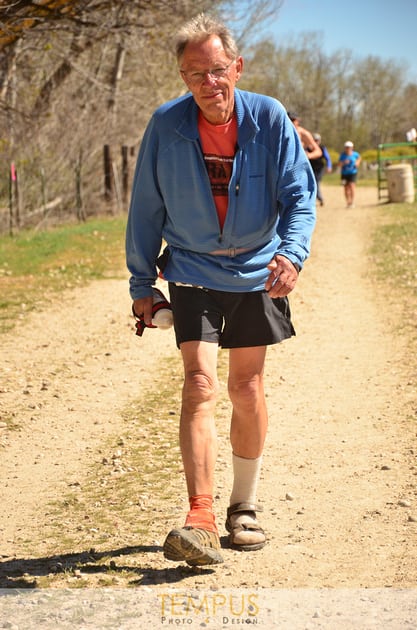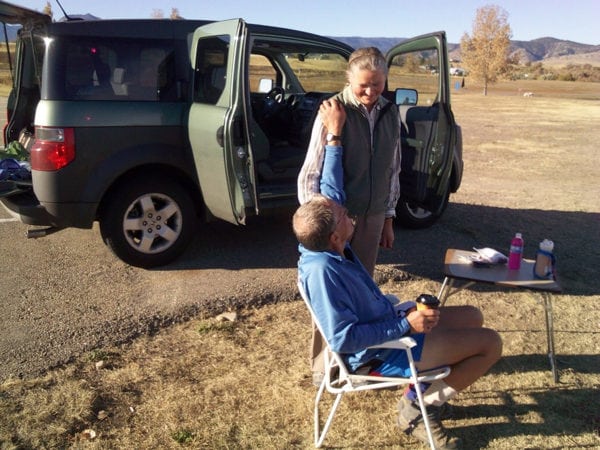“There is nothing like finishing 100 milers,” Ulli Kamm said. “I’ve done 200-plus miles nonstop…. but there is nothing like coming to a finish line of a 100 miler. I don’t need any awards. I just need my wife standing there and me knowing I finished the 100 miler and am in one piece. I am happy.”
Ulli is a special subject when it comes to the world of ultra races. His name has been appearing in races and results pages for years, but unless you’ve seen him really race, you know there is something more to this guy than competing.
Ulli does not sign up for the glory, the publicity, the belt buckle, or even the camaraderie found in ultra packs. Instead, he is out there to walk. To walk sections with friends. To walk the trails. To walk in whatever weather nature brings him. To walk up and down the mountains. To walk for himself.

Ulli finishing the 2006 Bighorn Mountain Wild and Scenic Trail 100 Mile Run with his wife Traudl. All photos courtesy of Ulli Kamm.
His competition is against his own thoughts and the clock. The red unwavering numbers, counting down the minutes toward each cutoff time.
“For preparing for [a 100 miler], it is more mental than physical,” he said. “I know the day will come when I don’t meet the cutoff and I will be late. I have to prepare mentally for that day.”
Ulli is an ultrawalker. At 69 years old and in his 50th year of ultrawalking, Ulli’s passion for the sport and trails is as alive and fresh as ever. He recently finished a 100 miler on just “training” or walking a total of two to three miles the week leading up to it, and has about four to five more ultra races planned for the rest of the year.
When I say ultrawalking–I mean, and he means–ultrawalking. He is not hiking and jogging. He is not running or taking extra-long walking sections on flat or hilly sections of a trail. He is walking all 100 or 50 or 60 miles or however many miles are in his race and enjoying every minute of it.
As runners get older, the amount of walking they do in races typically increases. And as a runner gets more tired during a long ultra, the same thing can happen. And neither of these situations are on purpose. However, for Ulli, it was always like this. He has always intentionally ultrawalked.
Ulli was born in Germany in 1947 and as a young child, around three years old, was quickly introduced to the mountains. It was in the Alps, climbing one day in the year 1974, when he met his wife Traudl, who shares his love of the mountains and nature and has completed about six ultras herself.
“I just love being out in the mountains and nature,” he said. “I am always hiking. I just enjoy doing it.”

Walking in a 28-hour race in Roubaix, France, in 1987.
It was in 1968, still overseas, when he did his first 100 miler. Having already finished a 50k in 1966 in Germany, he knew he was up to walking an ultra and finishing in time. A friend had asked him to join him in a race in Holland and–without knowing the distance ahead of time–Ulli said yes.
It was the toughest finish he’s ever had, he claims, and yet his love of endurance-walking races was born.
“Running requires training,” he stated. “Hiking in the mountains is always training.”
Ulli looks at every hike, walk of the dog, climb of three flights of stairs instead of an elevator as a training session for his next ultra.
The 100-mile distance is preferred, he said, because he can achieve everything he needs to within those miles and relishes in his belief that every 100-mile race is walkable.
He also has competed in two Centurion racewalking events. The Centurion races began in England in 1911 and are still held every year there and in six other countries including the United States. After finishing one you become part of the “Brotherhood of Centurions.” Ulli finished the race, which challenges its participants to walk 100 miles in 24 hours in England and in the Netherlands. Beyond the Centurion races, Ulli has racewalked to the finish of nine 100-mile races in under 24 hours.

Finishing the Centurion race held in London, England.
“I never care for records and rank,” he said. “I don’t mind being at the bottom of the pack. I just keep going and keep walking.”
In 50 years of competing, Ulli tributes his nearly injury-proof life to not having the stress of running take a toll on his body. The one injury he claims was not really an injury but painful enough to be forced from the race, was during a 24-hour run when a bone moved, pushing and straining a nerve in his leg.
He added, after a Barkley Marathons one year, his knee was so painful he could not do any ups and downs. He stuck to flat ultras for the next year instead.
He praises his 50 years of ultrawalking with one thing: his health, both mental and physical.
“I have learned how to overcome the challenges of life, the ups and downs, like the ups and downs of a race,” he explained. “My slogan is ‘just keep going,’” he stated.
Another big lesson learned every race? “Learning how fast I am at every moment. That is necessary to avoid missing cutoff times.”
When younger, Ulli said he was a middle-of- the-pack competitor, keeping the same steady pace the entire 100 miles. During his first Leadville Trail 100 Run, he reached the turnaround and passed 94 people on the way back, without anyone passing him. Now, while in the back of the pack of most races, his motivation is still the same as it was 20 years ago.

Trekking through the 2015 Pickled Feet 100 Mile Run.
“My motivation? I have my schedule and I stick to my schedule no matter what others are doing or saying,” he claims. “People at the aid station say I am not going to make it or other runners say I’m not going to make it, but I say no, I am a few minutes ahead of my schedule, I am going to make it. I trust my schedule and I trust my speed.”
His schedule affirms where he should be at each mile and aid station, based off the approaching cutoff time. Whether he is 10 minutes ahead or just three, he knows he is on track to finish, unless something truly unplanned happens. Coming in minutes before the cutoff? He’s pretty used to that, he said.
He’s also pretty used to his biggest supporter, his wife Traudl.
“She has been with me for 200 of these ultras, going from aid station to aid station, supporting me and cleaning up the mess I make at the aid station,” he said. “There were many races I could not have done without her. She was and still is the best aid-station person someone can have.”

Traudl keeping Ulli’s spirits up during the Foothills 50k Frenzy last year.
Nearing 70 though, the types of races he chooses to be involved in has changed. He picks races he knows he has at least a 50-percent chance of finishing and has the possibility of Traudl walking him in at the end.
The Hardrock 100 Mile Endurance Run, his favorite race and trail course of all, is no longer on that list. However, he will never forget those Silverton, Colorado trails and those who are still directing and racing will never forget him. Ulli is one of the few 10-plus-time finishers of the race. His last finish at the race was in 2004.
“Hardrock is my all-time favorite,” he claimed. “It will be always be my all-time favorite landscape. I like climbing mountains and in Hardrock I get to climb as many mountains as I want.”
When I see pictures of Hardrock, I think this has to be the hardest race in the country, but according to Ulli, it is subjective and depends on the runner. For Hardrock, he said, the challenges comes from the cutoff times and unpredictable weather. The climbing and descending of some 33,000-plus feet is the fun part, well maybe not fun, he said. It is the most enjoyable part for the climbing enthusiast, but the climbs are also the biggest factor in meeting the cutoff times.
Dale Garland, Hardrock’s race director, said when he first met Ulli and learned he was walking he thought, No way. According to Garland, Ulli’s legacy at Hardrock has been a greater self-confidence in people when finishing the race.
“We have people who still finish Hardrock because they learned that you can finish without running,” he said. “He is reserved, but he is a man who loved the mountains, loved the camaraderie of the people who came to share that love.”
His favorite Ulli story is when Ulli would tell him after a race how lonely he was during the part of the race, since everyone ran ahead and left him.
“Yet, at the finish line,” he said. “Here was Ulli with four, five, six people who he had picked up along the way and who finished because they stuck close to him and walked with him.”

Climbing through mud during the Alfred Packer Trail Marathon in 2004.
He believes there are several 100 milers where the course may not be as tough as Hardrock, but the cutoff time is shorter, a difficulty for back-of-the-pack runners.
During his first few times at Hardrock, Ulli thought one section of the race could be improved. In the early days of the race, the route between Silverton and Grant Swamp Pass was routed up the South Mineral Fork Road and the Ice Lake Trail. After looking through maps and even buying a hand-inscribed map from a land surveyor, Ulli tracked down some old mining trails, designed an alternate 14- to 15-mile route for that section, and submitted it to the directors.
It was tested and accepted, and it today remains the standard route connecting Silverton and Grant Swamp Pass. In that section of the course, there is the Kamm Traverse and the KT (Kamm Traverse) Aid Station. As you can imagine, these were named after Ulli.
“Yes that’s cool,” he said, reluctantly responding to my admiration. “But, that’s not why I suggested the change. I don’t like the exposure.”
With more exposure, comes more pressure according to the ultrawalker.
“I want to go into these races without pressure and enjoy doing it. That’s why I’m still here,” he said.

Taking a rest and getting help from his “anchor” during the 2009 Boulder 100 Endurance Running Race.
His race choices are founded on this mentality as well, which explains why Ulli has never been to Western States, a great event he believes, although a bit of a “circus” of a race for his mentality, and only has done Leadville, another type of circus, a few times because it was located near his home when he lived in Colorado.
His preferred races include a lot of nature, whatever nature can give him. The McNaughton Park Trail Run, now called the Potawatomi Trail Run in Illinois, is a good one, along with several others around his current home of Boise, Idaho, he said.
“I really like the nature there,” he said. “[Potowatomi] has three creeks and in the wet years, knee-deep mud, and some vertical up and down. I like tough environments.”
Of course Hardrock is a top one in his books. It has everything–mountains, night running, weather–basically just nature. Finishing within minutes of cutoff times means a lot of night runs and temperature changes. Over the 50 years of ultrawalking, he has run straight through 184 nights without a break or sleep.
“I got used to it,” he said. “The night is beautiful when the moon is showing and animals’ red eyes are looking at you and you hear a lot of noises around you. Night is special. I like being with other people, but I also like being in the quiet, peaceful hours alone through nature.”
Weather is just another aspect of the race.
“I like being a part of nature and rain is a part of nature,” he said. So is snow and cold winds, he added.
“I am not fighting the weather, it is nature,” he said. “It is natural and you have to be prepared for the weather. When the trail gets slippery or the rocks and roots, then that slows you down and then I am worried about cutoff times. That is the only problem I have with the weather.”
Hardrock is not an option anymore, a fact accepted by Ulli, who claims he could still do the race, but he thinks he’d need an extra eight hours or so to get around the loop.
But that still won’t slow him down, race-wise. So far this year he has completed two ultras and will have about three to four more to finish before 2016 comes to an end.
He is aware that in the coming years not meeting cutoff times will begin to get more difficult.

Walking in the night during the 1988 24-hour race in Pilsen (Plzen), Germany.
Until he wants to stop doing such races as often, his plan is to switch to 24-hour races or easier 50ks.
“And that is welcome,” he said. “I’m prepared for that.”
According to his calculations, he usually completed eight to nine (usually 100 milers) races a year and since 1989 has averaged 76 miles a race.
He buys a pair of shorts and one to two pair of shoes a year depending on the wear and tear, he said. He also logs every race, publishing a summary on his website, ultrawalk.com.
The site is a compilation of race results, photos, biographies, and other walkers of ultras. It also lists the numerous names of races he and his wife have directed over the years.
“I don’t remember how many years ago,” he answered, when asked when he began the website. “It was more or less for me to keep track of what I’m doing. How I got into this and my past.”
In the 50th year, the mile doesn’t get shorter and the toll on the body is not getting easier. The weather is never the same and the trails are constantly changing, but the clock never lies. It keeps going. 24 hours. 28 hours. 32 hours. Done. As Ulli gets older his priorities for this sport are becoming more focused.
They won’t include worrying about nutrition, weather, or even the cutoff time soon. It will just be about the relationship between Ulli and nature.

Ulli making his way through the McCall Trailrunning Classic 40 Mile in 2014.
Call for Comments (from Meghan)
- Have you ultrawalked with Ulli Kamm?
- If so, can you share some stories about him?
